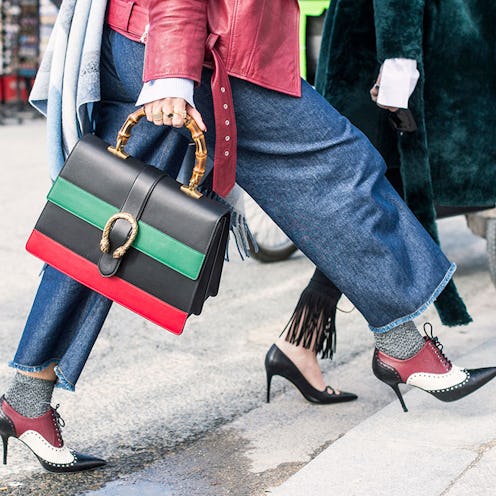Marquee photo: Julien Boudet/BFA.com
There are certain expectations that come with being a fashion editor—early adoption of trends and the foresight to pick up on what’s next being a couple. And while it may not be implied that you own every covetable item during any given season, you’re likely rocking some iteration of an It piece for prestige.
While perks abound in working in the fashion industry (namely gratis samples and discounts), the salaries of editors don’t necessarily afford a wardrobe exclusive to designer wares. So how do editors keep up with the Joneses while existing on a real-girl salary? Two words: Smart shopping.
The talk of the high-low mix—as in pairing a Chloe bag with a Zara dress—seems to have only escalated in the last several years. Not only is it a more attainable approach to the fashion cycle, it also considers the cost per wear of each item above all else. Thus, it’s become the MO for fashion girls and editors alike.
Here, we break down a smarter shopping strategy before you go all-in with your spring spending.
Photo: Getty Images
Where To Go Big
The natural starting point in splurging on big-ticket items is accessories. Things like shoes, sunglasses and handbags lend themselves to more frequent wear than most items of clothing, and having a high-quality statement add-on can instantly make your outfit look more expensive. In order to strategize your investment, first determine whether you have the budget to buy these items quarterly, yearly or once in a blue moon. From there, create a wishlist or visual inspiration board on Pinterest of items you’re currently coveting. Revisiting this frequently will help you pull out key trends in what kind of item you’re gravitating towards—plus, actively mulling over a potential purchase will force you to think about how much value you’ll actually get from it. Pit these contenders against one another—“which will I wear more often” and “which fills a void in my closet” are two questions we often ask ourselves. By having considered all of these factors with such intention, by the time your budget allows, you can feel confident and excited in the item knowing you’ve made a thoughtful purchase. If the piece starts to feel stale as time goes on, you can also resell these luxury items (assuming they’re in decent condition) on sites such as Vestiaire Collective, The Real Real, etc. to get a chunk of change back to put towards your next big purchase.
Where To Scale Back
While you could probably make a case for splurging on just about every item that you encounter when shopping (“It looks so good on me! It’s super special! I’ve never seen anything like it!”) you probably don’t have the deep pockets of a gazillionaire—and have more important things in your life to put money towards than just clothes—so reigning in spending becomes essential. While certain versatile staples are worth investing in (say, an incredible blazer, leather leggings or a well-fitting LBD), many supplementary items simply aren’t. For pieces that aren’t super tailored, feel rooted in a very timely (and likely fleeting) trend or that you only plan to wear for one occasion, you don’t need to shell out the big bucks. By going the wallet-friendly route with these buys, you can allocate the saved cash towards more time-tested, superbly fitting items. Consider renting clothing from Rent The Runway for a one-time-only event if you can’t find an affordable version you like. Also, consider what the fabrics look and feel like of your purchases in question—if you can’t really tell the difference between a high-end and budget item, it behooves you to opt for the less expensive option.
Know Your Stores' Strengths
While you might have your favorite designers, you likely look to them for different categories—while one might be your go-to for romantic, flirty dresses, you might tap another for your office attire. Go into each store with an intention of what you actually need, and don’t be tempted by sales or impulse purchases just because something is in front of your face. Furthermore, you can score great deals at vintage retailers if you know what to look for. Heirloom and statement jewelry in particular, sourced from Etsy, eBay or a local antique shop, can go for insanely low prices—not to mention will feel more special and substantial than a cheap piece from the mall. You can also find truly unique outerwear, dresses and accessories by going the vintage route—and unless it’s a super rare gem, it’ll definitely come in at a lower price relative to buying new. Just remember to budget in tailoring and alterations for these pieces for the perfect fit.
Don't Neglect The Basics
It can often feel less “fun” to replenish undergarments and basics, but when you take a step back and consider that these are the very foundation upon which your wardrobe is built, it becomes hard to refute their importance. Depending on how much wear these items get—think: bras, panties and cotton tanks, t-shirts and long sleeves—budget being able to refresh this arsenal accordingly. Before you go out and buy 10 new white t-shirts, take heed—you don’t have to go crazy in stocking up on these staples. Think of it more on an as-needed basis to ensure you have a solid but well-edited lineup. Furthermore, a well-fitting bra and the proper underwear can make your garments look that much more polished.
